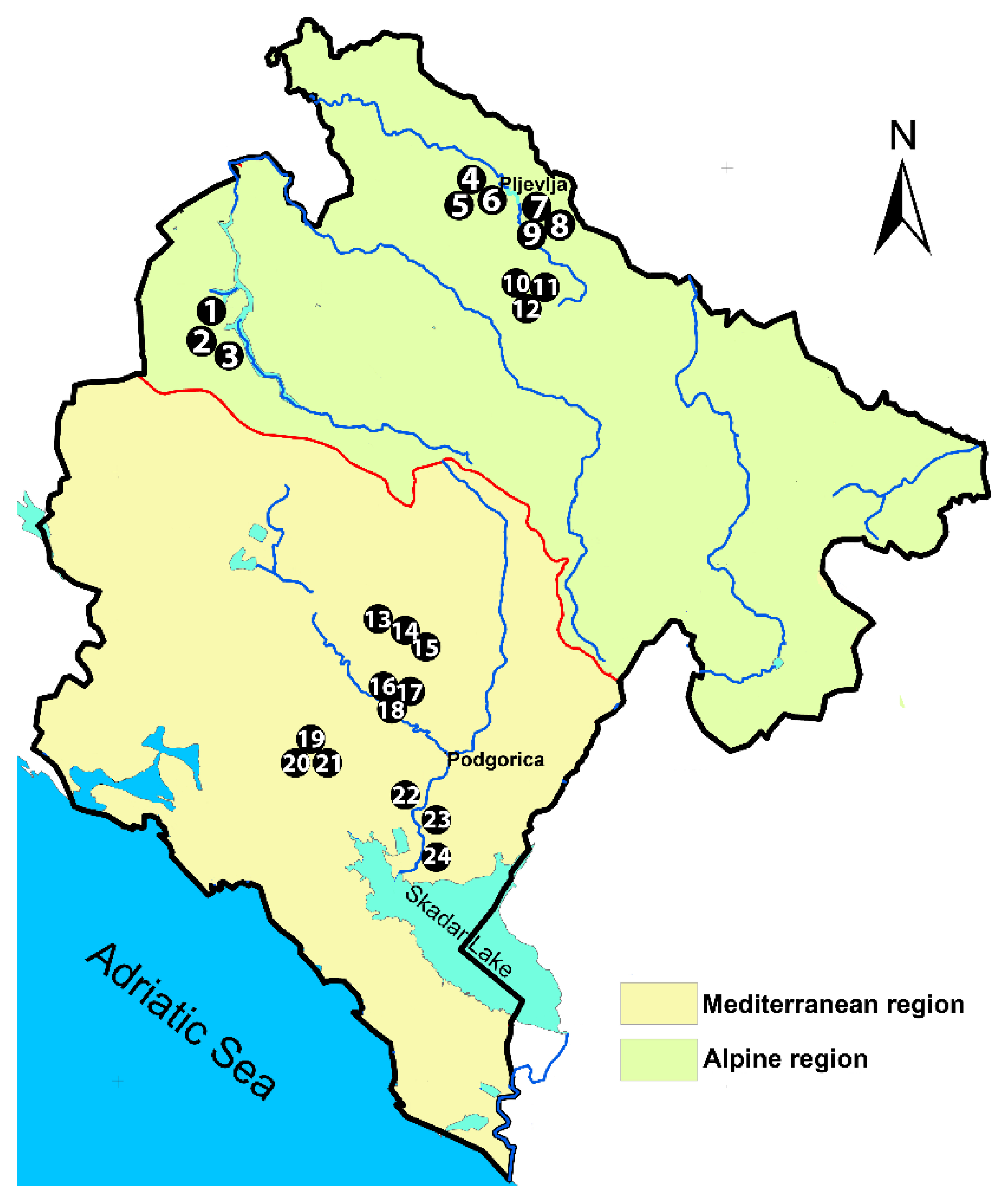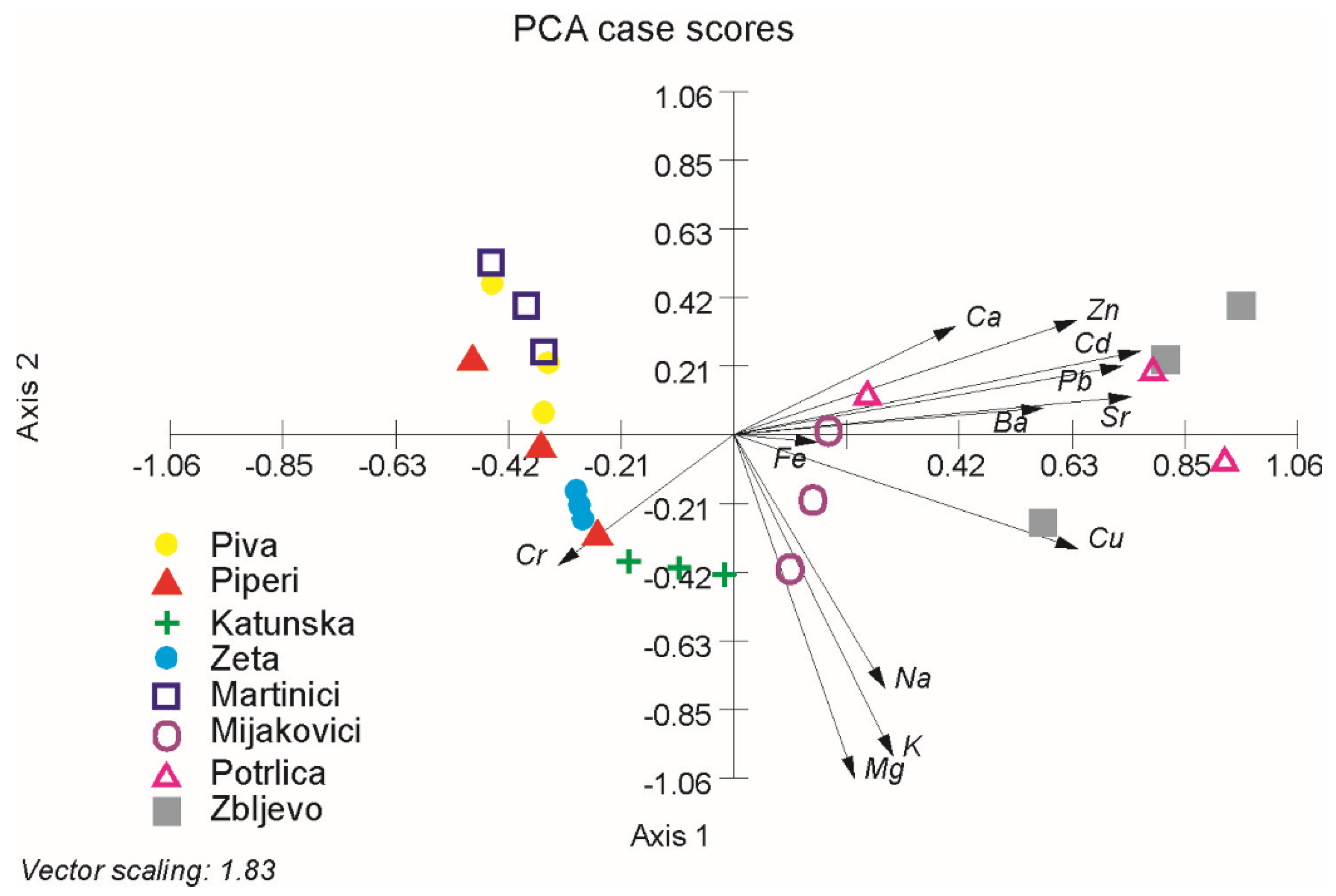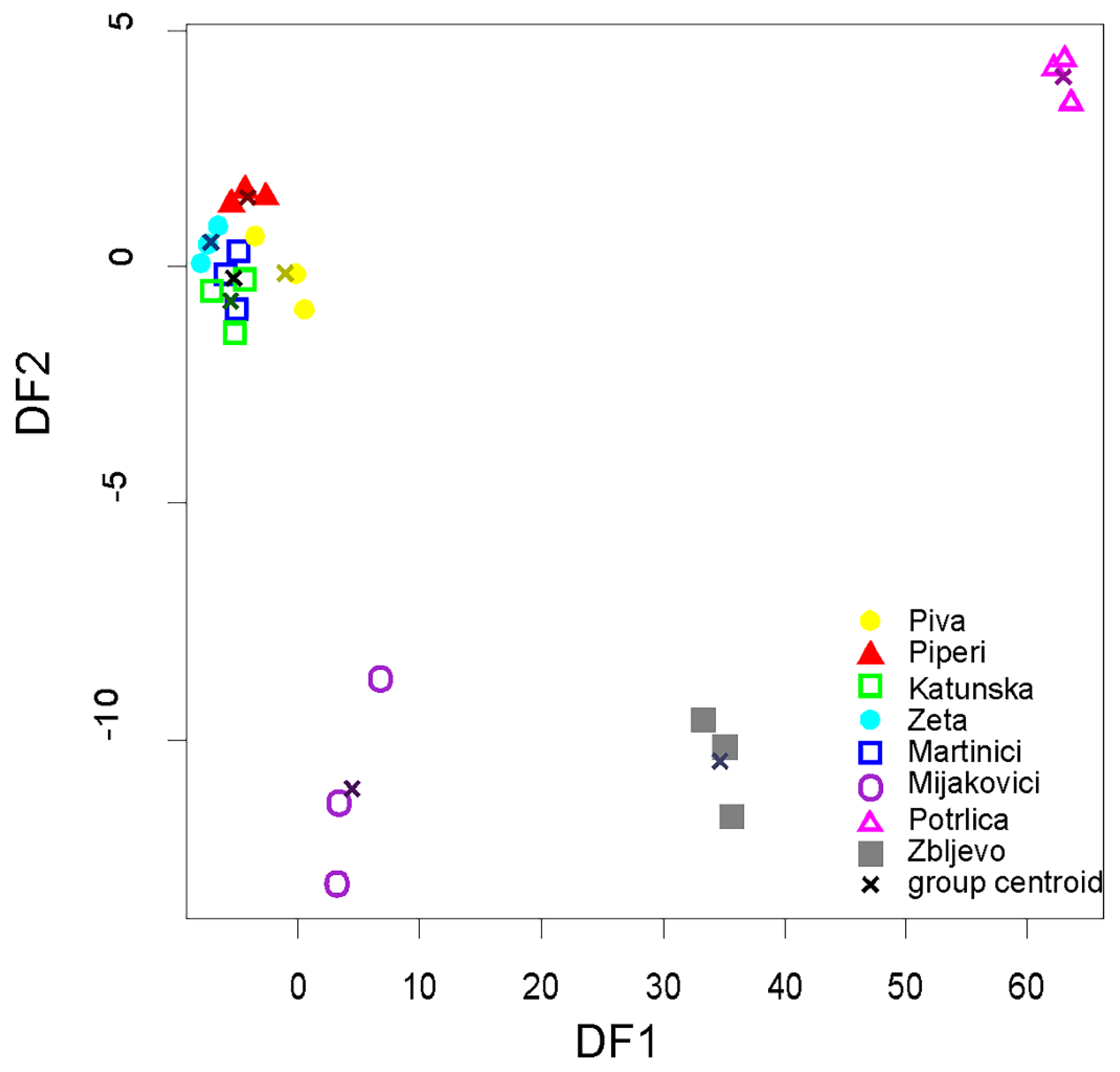Using Chemometric Analyses for Tracing the Regional Origin of Multifloral Honeys of Montenegro
Abstract
1. Introduction
2. Materials and Methods
3. Results
4. Discussion
Author Contributions
Funding
Conflicts of Interest
References
- Lazarević, K.; Trifković, J.; Andric, F.; Tešić, Ž.; Anđelković, I.; Radovic, D.; Nedić, N.; Milojković-Opsenica, D. Quality parameters and pattern recognition methods as a tool in tracing the regional origin of multifloral honey. J. Serb. Chem. Soc. 2013, 78, 1875–1892. [Google Scholar] [CrossRef]
- Leita, L.; Muhlbachova, G.; Cesco, S.; Barbattini, R.; Mondini, C. Investigation on the Use of Honeybees and Honeybee Products to Assess Heavy Metal Contamination. Environ. Monit. Assess. 1996, 43, 1–9. [Google Scholar] [CrossRef] [PubMed]
- Karabagias, I.; Karabournioti, S. Discrimination of clover and citrus honeys from Egypt according to floral type using easily assessable physicochemical parameters and discriminant analysis: An external validation of the chemometric approach. Foods 2018, 7, 70. [Google Scholar] [CrossRef] [PubMed]
- Oroian, M.; Prisacaru, A.; Hretcanu, E.C.; Stroe, S.G.; Leahu, A.; Buculei, A. Heavy Metals Profile in Honey as a Potential Indicator of Botanical and Geographical Origin. Int. J. Food Prop. 2016, 19, 1825–1836. [Google Scholar] [CrossRef]
- Paul, S.; Hossen, M.S.; Tanvir, E.M.; Afroz, R.; Hossen, D.; Das, S.; Bhoumik, N.C.; Karim, N.; Juliana, F.M.; Hua Gan, S.; et al. Minerals, Toxic Heavy Metals, and Antioxidant Properties of Honeys from Bangladesh. J. Chem. 2017. [Google Scholar] [CrossRef]
- Porrini, C.; Sabatini, A.G.; Girotti, S.; Ghini, S.; Medrzycki, P.; Grillenzoni, F.; Bortolotti, L.; Gattavecchia, E.; Celli, G. Honey bees and bee products as monitors of the environmental contamination. Apiacta 2003, 38, 63–70. [Google Scholar]
- Staniskiene, B.; Matusevicius, P.; Budreckiene, R. Honey as an indicator of environmental pollution. Environ. Res. Eng. Manag. 2006, 2, 53–58. [Google Scholar]
- Sector Study for the Preparation of the Strategy for the Development of Agriculture and Rural Areas 2014–2020. Union of Beekeeping Organizations of Montenegro. 2014. Available online: https://pcelarstvo.me/wpx/wp-content/uploads/2017/01/Studije-o-proizvodnji-meda.pdf?x46702 (accessed on 23 December 2019).
- Market research of Bee Products in Montenegro. Union of Beekeeping Organizations of Montenegro. 2016. Available online: https://pcelarstvo.me/wpx/wp-content/uploads/2017/02/Istrazivanje-trzista-pcelinjih-proizvoda-u-Crnoj-Gori.pdf?x46702 (accessed on 23 December 2019).
- Pešić, V.; Grabowski, M.; Hadžiablahović, S.; Marić, D.; Paunović, M. The Biodiversity and Biogeographical Characteristics of the River Basins of Montenegro. In The Rivers of Montenegro; Pešić, V., Paunović, M., Kostianoy, A., Eds.; The Handbook of Environmental Chemistry; Springer: Cham, Switzerland, 2019. [Google Scholar] [CrossRef]
- Bogdanov, S. Harmonised Methods of the International Honey Commission, International Honey Commission, Internet Publication. 2002. Available online: http://www.apiculturacluj.com/ApiculturaCluj/italiano/Documents/IHCmethods_e.pdf (accessed on 23 December 2019).
- Commission Regulation No 1881/2006, the Framework EU Legislation Which Sets Maximum Levels for Chemical Contaminants in Foodstuffs. Available online: https://eur-lex.europa.eu/LexUriServ/LexUriServ.do?uri=OJ:L:2006:364:0005:0024:EN:PDF (accessed on 23 December 2019).
- Lazarević, K. Physico-Chemical Characterization and Classification of Honey from the Territory of The Republic of Serbia According to Regional and Botanical Origin Using Multivariate Chemometric Analysis. Ph.D. Thesis, Faculty of Chemistry, University of Belgrade, Belgrade, Serbia, 2016. [Google Scholar]
- Perna, A.; Intaglietta, I.; Simonetti, A.; Gambacorta, E. Metals in Honeys from Different Areas of Southern Italy. Bull. Environ. Contam. Toxicol. 2014, 92, 253–258. [Google Scholar] [CrossRef]
- Bilandžić, N.; Tlak Gajger, I.; Čalopek, B.; Sedak, M.; Solomun Kolanović, B.; Varenina, I.; Božić Luburić, Đ.; Varga, I.; Đokić, M. Content of Heavy Metals and Trace Elements in Different Types of Honey from Dubrovnik Country. Vet. Stn. 2015, 46, 359–368. [Google Scholar]
- Tanković, S.; Jelušić, V.; Bilandžić, N.; Čalopek, B.; Sedak, M.; Ferizbegović, J. Concentrations of Heavy Metals and Elements in Different Types of Honey from Bosnia and Herzegovina. Vet. Stn. 2017, 48, 1–12. [Google Scholar]
- Corredera, L.; Bayarri, S.; Pérez-Arquillué, C.; Lázaro, R.; Molino, F.; Herrera, A. Evaluation of Heavy Metals and Polycyclic Aromatic Hydrocarbons in Honeys from Different Origins. J. Food Prot. 2014, 77, 504–509. [Google Scholar] [CrossRef] [PubMed]
- Kropf, U.; Bertoncelj, J.; Korošec, M.; Nečemer, M.; Kump, P.; Ogrinc, N.; Golob, T. Geographical origin of Slovenian multifloral and forest honey. Apiacta 2009, 44, 33–42. [Google Scholar]
- Bilandžić, N.; Gačić, M.; Đokić, M.; Sedak, M.; Ivanec Šipušić, Đ.; Končurat, A.; Tlak Gajger, I. Major and trace elements levels in multifloral and unifloral honeys in Croatia. J. Food Compos. Anal. 2014, 33, 123–138. [Google Scholar] [CrossRef]



| Regions | Cu mg/kg | Zn mg/kg | Fe mg/kg | Cr mg/kg | Ca mg/kg | Na mg/kg | K mg/kg | Mg mg/kg | Pb mg/kg | Cd mg/kg | Sr mg/kg | Ba mg/kg | EC mS/cm | pH | Moisture % | Free Acidity meq/kg | |
|---|---|---|---|---|---|---|---|---|---|---|---|---|---|---|---|---|---|
| Katunska | Mean | 0.78 | 1.61 | 13.00 | 0.90 | 100.49 | 53.62 | 2155.00 | 76.33 | ND * | ND | ND | ND | 0.39 | 4.43 | 16.15 | 25.00 |
| SD | 0.15 | 0.01 | 1.00 | 0.50 | 3.35 | 6.58 | 115.00 | 14.74 | 0.08 | 0.08 | 0.37 | 7.21 | |||||
| Martinići | Mean | 0.31 | 1.18 | 7.67 | 0.30 | 109.82 | 34.61 | 713.00 | 31.38 | ND | ND | ND | ND | 0.82 | 3.95 | 15.40 | 29.33 |
| SD | 0.09 | 0.60 | 1.53 | 0.10 | 1.36 | 2.24 | 252.00 | 11.89 | 0.04 | 0.17 | 1.16 | 3.51 | |||||
| Mijakovići | Mean | 0.62 | 1.40 | 3.95 | 0.10 | 80.50 | 46.00 | 2589.33 | 68.77 | 0.08 | 0.02 | 0.07 | 0.27 | 0.86 | 4.49 | 16.04 | 30.00 |
| SD | 0.08 | 0.00 | 1.05 | 0.01 | 29.50 | 4.00 | 652.50 | 9.75 | 0.01 | 0.00 | 0.01 | 0.11 | 0.09 | 0.14 | 0.49 | 3.61 | |
| Piperi | Mean | 0.53 | 0.84 | 14.67 | 1.13 | 76.70 | 39.93 | 1760.00 | 37.91 | ND | ND | ND | ND | 0.75 | 4.48 | 14.92 | 28.00 |
| SD | 0.18 | 0.19 | 2.52 | 0.15 | 3.04 | 5.72 | 685.00 | 12.12 | 0.11 | 0.35 | 0.78 | 2.00 | |||||
| Piva | Mean | 0.53 | 0.52 | 7.33 | 0.27 | 74.65 | 39.76 | 844.33 | 29.52 | ND | ND | ND | ND | 0.44 | 3.87 | 15.36 | 41.67 |
| SD | 0.17 | 0.16 | 1.53 | 0.15 | 22.46 | 8.62 | 333.78 | 12.31 | 0.21 | 0.36 | 0.44 | 12.10 | |||||
| Potrlica | Mean | 0.87 | 3.00 | 7.53 | 0.12 | 152.00 | 46.00 | 1945.33 | 61.83 | 0.12 | 0.08 | 0.08 | 1.44 | 0.68 | 4.32 | 16.05 | 37.00 |
| SD | 0.22 | 0.61 | 6.05 | 0.07 | 84.26 | 8.54 | 189.72 | 9.22 | 0.02 | 0.01 | 0.05 | 1.67 | 0.20 | 0.19 | 1.43 | 11.14 | |
| Zbljevo | Mean | 0.98 | 4.13 | 15.93 | 0.26 | 103.00 | 56.67 | 1651.33 | 41.00 | 0.21 | 0.07 | 0.12 | 0.62 | 0.63 | 4.11 | 15.40 | 36.33 |
| SD | 0.19 | 3.30 | 5.71 | 0.06 | 10.15 | 3.51 | 1005.47 | 17.78 | 0.06 | 0.01 | 0.00 | 0.34 | 0.32 | 0.36 | 0.14 | 3.51 | |
| Zeta | Mean | 0.47 | 0.93 | 11.00 | 0.47 | 48.88 | 63.94 | 1285.00 | 57.23 | ND | ND | ND | ND | 0.93 | 4.34 | 16.22 | 32.00 |
| SD | 0.02 | 0.29 | 0.00 | 0.07 | 2.20 | 3.46 | 135.00 | 0.17 | 0.15 | 0.23 | 0.36 | 12.12 | |||||
| Total | Mean | 0.64 | 1.64 | 10.14 | 0.44 | 93.25 | 47.57 | 1617.92 | 50.50 | 0.05 | 0.02 | 0.03 | 0.29 | 0.69 | 4.25 | 15.69 | 32.42 |
| SD | 0.25 | 1.59 | 4.80 | 0.40 | 40.15 | 10.58 | 750.73 | 19.77 | 0.08 | 0.03 | 0.05 | 0.70 | 0.24 | 0.31 | 0.79 | 8.49 | |
| F a/χ2 b | 6.59 a | 3.17 a | 5.08 a | 10.65 a | 2.64 a | 8.68 a | 4.61 a | 6.63 a | 22.87 b | 22.57 b | 22.06 b | 21.62 b | 3.79 a | 2.69 a | 1.17 a | 1.42 a | |
| significance | 0.001 c | 0.026 c | 0.003 c | 0.000 c | 0.051 c | 0.000 c | 0.005 c | 0.001 c | 0.002 d | 0.002 d | 0.002 d | 0.003 d | 0.013 c | 0.048 c | 0.373 c | 0.263 c | |
| Electrical Conductivity | pH | Moisture | Free Acidity | ||
|---|---|---|---|---|---|
| Pb | R | −0.028 | −0.052 | 0.013 | 0.224 |
| Cd | R | −0.087 | −0.030 | 0.080 | 0.259 |
| Cu | R | −0.239 | 0.240 | −0.043 | −0.029 |
| Zn | R | −0.329 | −0.183 | 0.052 | 0.035 |
| Fe | R | −0.379 | 0.044 | −0.115 | −0.194 |
| Cr | R | −0.179 | 0.335 | −0.069 | −0.285 |
| Sr | R | −0.006 | 0.074 | 0.009 | 0.125 |
| Ba | R | −0.064 | 0.114 | −0.275 | −0.082 |
| Ca | R | −0.229 | −0.019 | -0.031 | −0.061 |
| Na | R | 0.079 | 0.382 | 0.214 | −0.173 |
| K | R | 0.171 | 0.800 ** | 0.218 | −0.250 |
| Mg | R | 0.159 | 0.758 ** | 0.325 | −0.391 |
| Predicted | Piva | Piperi | Katunska | Zeta | Martinići | Mijakovići | Potrlica | Zbljevo |
|---|---|---|---|---|---|---|---|---|
| Piva | 66.67% | 0.00% | 0.00% | 0.00% | 33.33% | 0.00% | 0.00% | 0.00% |
| Piperi | 0.00% | 100.00% | 33.33% | 0.00% | 0.00% | 0.00% | 0.00% | 0.00% |
| Katunska | 0.00% | 0.00% | 33.33% | 0.00% | 0.00% | 0.00% | 0.00% | 0.00% |
| Zeta | 0.00% | 0.00% | 0.00% | 100.00% | 0.00% | 0.00% | 0.00% | 0.00% |
| Martinići | 33.33% | 0.00% | 0.00% | 0.00% | 66.67% | 0.00% | 0.00% | 0.00% |
| Mijakovići | 0.00% | 0.00% | 0.00% | 0.00% | 0.00% | 100.00% | 0.00% | 0.00% |
| Potrlica | 0.00% | 0.00% | 0.00% | 0.00% | 0.00% | 0.00% | 66.67% | 0.00% |
| Zbljevo | 0.00% | 0.00% | 33.33% | 0.00% | 0.00% | 0.00% | 33.33% | 100.00% |
© 2020 by the authors. Licensee MDPI, Basel, Switzerland. This article is an open access article distributed under the terms and conditions of the Creative Commons Attribution (CC BY) license (http://creativecommons.org/licenses/by/4.0/).
Share and Cite
Vukašinović-Pešić, V.; Blagojević, N.; Brašanac-Vukanović, S.; Savić, A.; Pešić, V. Using Chemometric Analyses for Tracing the Regional Origin of Multifloral Honeys of Montenegro. Foods 2020, 9, 210. https://doi.org/10.3390/foods9020210
Vukašinović-Pešić V, Blagojević N, Brašanac-Vukanović S, Savić A, Pešić V. Using Chemometric Analyses for Tracing the Regional Origin of Multifloral Honeys of Montenegro. Foods. 2020; 9(2):210. https://doi.org/10.3390/foods9020210
Chicago/Turabian StyleVukašinović-Pešić, Vesna, Nada Blagojević, Snežana Brašanac-Vukanović, Ana Savić, and Vladimir Pešić. 2020. "Using Chemometric Analyses for Tracing the Regional Origin of Multifloral Honeys of Montenegro" Foods 9, no. 2: 210. https://doi.org/10.3390/foods9020210
APA StyleVukašinović-Pešić, V., Blagojević, N., Brašanac-Vukanović, S., Savić, A., & Pešić, V. (2020). Using Chemometric Analyses for Tracing the Regional Origin of Multifloral Honeys of Montenegro. Foods, 9(2), 210. https://doi.org/10.3390/foods9020210






